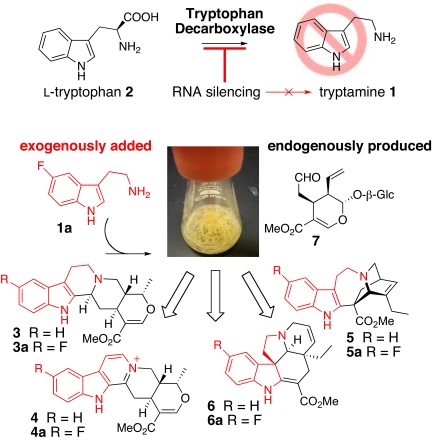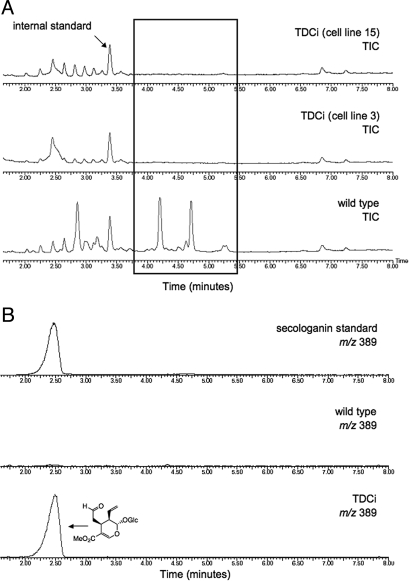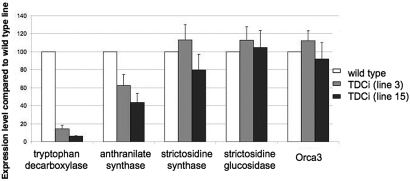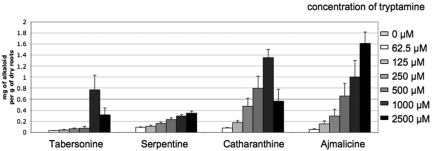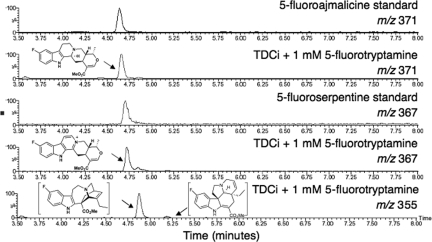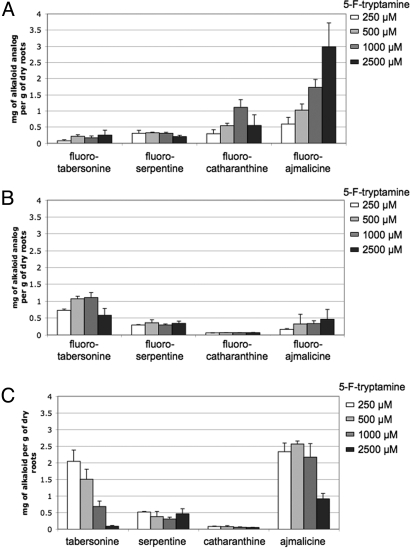Abstract
Natural products have long served as both a source and inspiration for pharmaceuticals. Modifying the structure of a natural product often improves the biological activity of the compound. Metabolic engineering strategies to ferment “unnatural” products have been enormously successful in microbial organisms. However, despite the importance of plant derived natural products, metabolic engineering strategies to yield unnatural products from complex, lengthy plant pathways have not been widely explored. Here, we show that RNA mediated suppression of tryptamine biosynthesis in Catharanthus roseus hairy root culture eliminates all production of monoterpene indole alkaloids, a class of natural products derived from two starting substrates, tryptamine and secologanin. To exploit this chemically silent background, we introduced an unnatural tryptamine analog to the production media and demonstrated that the silenced plant culture could produce a variety of novel products derived from this unnatural starting substrate. The novel alkaloids were not contaminated by the presence of the natural alkaloids normally present in C. roseus. Suppression of tryptamine biosynthesis therefore did not appear to adversely affect expression of downstream biosynthetic enzymes. Targeted suppression of substrate biosynthesis therefore appears to be a viable strategy for programming a plant alkaloid pathway to more effectively produce desirable unnatural products. Moreover, although tryptamine is widely found among plants, this silenced line demonstrates that tryptamine does not play an essential role in growth or development in C. roseus root culture. Silencing the biosynthesis of an early starting substrate enhances our ability to harness the rich diversity of plant based natural products.
Keywords: metabolic engineering, natural products
Genetic manipulation of natural product biosynthetic pathways has emerged as a powerful strategy to rapidly access complex novel molecules (1). In one approach, the producer organism is supplemented with analogs of the naturally occurring starting materials where, ideally, these nonnatural starting materials are converted by the enzymes of the biosynthetic pathway into the corresponding unnatural products (2). The yields and purity of these unnatural products is typically improved if the biosynthesis of the natural starting material is genetically blocked, and the producing organism is forced to use exogenously supplied precursors for product biosynthesis. This strategy, termed mutasynthesis, was first applied several decades ago to yield novel antibiotics in the soil bacterium Streptomyces fradiae (3). Although mutasynthesis has proven to be highly successful in microbial systems (4, 5), the strategy has not been applied in more complex eukaryotes, notably plants. Here, we describe mutasynthesis of the monoterpene indole alkaloids in the medicinal plant Madagascar periwinkle (Catharanthus roseus).
Tryptamine 1 is the starting substrate for hundreds of monoterpene indole alkaloids produced by C. roseus (Fig. 1) (6, 7). This substrate is produced enzymatically from tryptophan 2 by tryptophan decarboxylase, an enzyme that serves as a key link between primary metabolism and natural product metabolism (8, 9). If tryptamine biosynthesis was blocked, alkaloid biosynthesis could be rescued by introducing exogenous tryptamine or tryptamine analogs to plant cell culture (Fig. 1). Precursor directed biosynthesis with wild-type C. roseus plants and tissue culture has already demonstrated that tryptamine analogs can be taken up and processed by the plant into a wide variety of alkaloids (10, 11). However, if tryptamine 1 is required for plant growth or survival, silenced lines would not be viable. No studies of down-regulating or suppressing tryptamine biosynthesis in plants have been described, and little information is available in the literature to support a definitive role for tryptamine, a metabolite that is found throughout the plant kingdom (12). Overproduction of tryptamine has been shown to deter insect feeding (13), but this role is nonessential in the controlled environment of plant cell culture. Additionally, 5-hydroxytryptamine (serotonin), which may be produced by hydroxylation of tryptamine, has been implicated in certain physiological roles such as flower development (14). Notably, tryptamine may also be involved in auxin biosynthesis (15).
Fig. 1.
Tryptamine 1 is produced by enzymatic decarboxylation of tryptophan 2. Trypamine 1 reacts with secologanin 7 to yield a variety of monoterpene indole alkaloids. Ajmalicine 3, serpentine 4, catharanthine 5, and tabersonine 6 are produced in Catharanthus roseus hairy root culture.
Despite the uncertainty concerning the function of tryptamine in plants, suppression of tryptophan decarboxylase nevertheless provided an attractive entry point for introduction of new substrate analogs. In prokaryotic pathways, the gene of interest is usually deleted or “knocked out” using homologous recombination based strategies. However, although some success has been achieved with homologous recombination in higher plants (16), strategies to down-regulate or knockdown specific gene expression levels using RNA silencing are extremely well established for plants and these lines can be constructed on a relatively short time scale (≈6–9 months) (17–19).
Here, we successfully demonstrate RNA silencing of tryptophan decarboxylase to suppress the biosynthesis of tryptamine in C. roseus culture. Alkaloid production almost completely disappeared in silenced cultures and could be rescued by the addition of exogenous tryptamine to the culture medium. A representative unnatural tryptamine analog, 5-fluorotryptamine 1a, was also incorporated into the pathway to yield several unnatural, fluorinated alkaloids. Disruption of this early biosynthetic gene did not impact the expression of known downstream alkaloid biosynthetic enzymes, indicating that changes can be made in the early part of this pathway without adversely affecting the alkaloid biosynthetic machinery. Moreover, these experiments demonstrate that tryptamine and monoterpene indole alkaloids do not play an essential role in growth or development in C. roseus hairy root culture.
Results
Alkaloid Production in Tryptophan Decarboxylase Silenced Lines.
Tryptophan decarboxylase, a pyridoxal phosphate dependent enzyme that produces tryptamine 1 from tryptophan 2 (8, 9), was targeted for gene silencing (19–22) (Fig. 1). The plasmid designed to suppress tryptophan decarboxylase (pTDCi) was transformed into Agrobacterium rhizogenes, which was then used to infect C. roseus seedlings to generate hairy root culture as described in refs. 23 and 24. Hairy root lines harboring the pTDCi silencing plasmid were cultured in liquid media, and alkaloids were extracted from the plant tissue according to standard protocols. Gratifyingly, production of all major tryptamine derived alkaloids ajmalicine 3, serpentine 4, catharanthine 5 and tabersonine 6 was substantially decreased in the five silenced lines that were examined (Fig. 2A and SI). Suppression of alkaloid production appears to be stable, with little change in alkaloid production levels after seven subcultures performed thus far.
Fig. 2.
Metabolite production in wild-type and tryptophan decarboxylase suppressed lines as evidenced by LC-MS analysis of C. roseus extracts. (A) Alkaloid production monitored in the total ion count of a wild-type and a representative silenced line. (B) Secologanin 7 (m/z 389) production in wild-type and a representative silenced line. An authentic standard of secologanin is also shown.
Gene Expression in Silenced Lines.
Real time reverse transcription PCR confirmed that the tryptophan decarboxylase gene was significantly down regulated at the mRNA level in two representative lines harboring the pTDCi silencing plasmid (Fig. 3). Tryptophan decarboxylase is regulated by the transcription factor Orca3 (25), which also controls a number of other alkaloid biosynthetic genes including strictosidine synthase (26) and strictosidine glucosidase (27), enzymes that act immediately after tryptophan decarboxylase in the alkaloid biosynthetic pathway. The mRNA levels of strictosidine synthase, strictosidine glucosidase and Orca3 did not appear to be affected, indicating that the tryptophan decarboxylase gene could be silenced without perturbating the downstream pathway (Fig. 3). In contrast, down-regulation of a late stage morphine biosynthetic gene had an unpredictable effect on morphine biosynthesis, suggesting that suppression of a single metabolic enzyme can sometimes affect other pathway enzymes (28–30). Finally, the gene encoding the alpha subunit of anthranilate synthase (31), an enzyme involved in tryptophan 2 biosynthesis, showed modest decreases in expression levels in the silenced lines (Fig. 3). Increased concentrations of tryptophan inhibit anthranilate synthase expression (32). Therefore, in the silenced lines, where tryptophan is no longer diverted to tryptamine biosynthesis, concentrations of tryptophan could increase, resulting in the decreased expression of anthranilate synthase. A full transcriptional analysis of the monoterpene indole alkaloid pathway was not performed because the majority of the pathway enzymes are not known at the genetic level.
Fig. 3.
Real time reverse transcriptase PCR of the mRNA encoding tryptophan decarboxylase, anthranilate synthase, strictosidine synthase, strictosidine glucosidase and Orca3. Levels of these genes are normalized to 100% in the wild-type line. The gene expression levels of two representative silenced lines relative to the wild-type levels are also shown. Levels represent the average of three trials, with error bars representing the standard deviation.
Unnatural Alkaloid Production in Suppressed Lines.
Alkaloid biosynthesis could be rescued by feeding tryptamine 1 or isotopically labeled d4-(deuterium) tryptamine to silenced cultures. We measured formation of the major alkaloids of hairy root culture, namely ajmalicine 3, serpentine 4, catharanthine 5 and tabersonine 6 (Fig. 1). The identity of these alkaloids was assigned by exact mass and coelution with authentic standards (SI). Isotopically labeled d5-l-tryptophan (500 μM) was also incubated with a wild-type and a representative silenced line. As expected, the wild-type culture could incorporate the exogenous isotopically labeled tryptophan into alkaloids whereas the suppressed line could not, clearly indicating that the required decarboxylation reaction did not occur when tryptophan decarboxylase was knocked down (SI).
A hairy root line that showed maximal suppression of alkaloid production was incubated with varying concentrations of tryptamine 1 (62.5–2,500 μM) in the cell culture media (Fig. 4). The production of ajmalicine 3, serpentine 4, catharanthine 5, and tabersonine 6 were monitored by mass spectrometry in tandem with high performance liquid chromatography. The production levels increased as more tryptamine was added to the media, although catharanthine 5 and tabersonine 6 production was highest at 1,000 μM tryptamine 1. Notably, growth inhibition and browning of wild-type hairy roots was typically observed when exogenous tryptamine was added to the media of wild-type cultures at concentrations of 1,000 μM or greater, but this was not observed in the silenced lines where the natural tryptamine production was suppressed.
Fig. 4.
Levels of ajmalicine 3, serpentine 4, catharanthine 5, and tabersonine 6 production in a representative silenced line supplemented with tryptamine 1 (0, 50, 125, 250, 500, 1,000, 2,500 μM) in the culture media. Levels were estimated in C. roseus extracts by LC-MS.
These suppressed C. roseus lines provided the first opportunity to explore the prospects of mutasynthesis—replacement of natural alkaloids with unnatural products—in plant culture. A representative tryptamine analog, 5-fluorotryptamine 1a (Fig. 1), was chosen to illustrate the potential of mutasynthesis for the monoterpene indole class of alkaloids. The 5-fluorotryptamine substrate 1a has been shown in precursor directed feeding studies (10) to be turned over by downstream biosynthetic enzymes to yield a variety of fluorinated monoterpene indole alkaloid analogs. A representative silenced line was incubated with varying concentrations (250–2,500 μM) of 5-fluorotryptamine 1a. Two representative fluorinated alkaloids, fluoro-ajmalicine 3a, and fluoro-serpentine 4a were identified by exact mass (SI), UV spectrum (SI) and by coelution with authentic standards that were characterized by NMR (10) (Fig. 5). When supplemented with natural tryptamine 1, silenced hairy root cultures produced catharanthine 5 and tabersonine 6 as the only observable compounds with m/z 337. When supplemented with 5-fluorotryptamine 1a, silenced lines yielded two compounds at m/z (337 + 18), the expected molecular weight of fluoro-catharanthine 5a (expected, 355.1816; observed, 355.1818) and fluoro-tabersonine 6a (expected, 355.1816; observed, 355.1811). UV spectra of these two compounds matched authentic standards of catharanthine 5 and tabersonine 6 (SI). Finally, mass spectrometry analysis showed that the fragmentation pattern of 5a was identical to an authentic standard of 5, and the fragmentation pattern of 6a was identical to an authentic standard of 6 (SI). Collectively, these data strongly suggested a structural assignment of 5a and 6a.
Fig. 5.
Extracted LC-MS chromatograms showing the presence of fluorinated ajmalicine 3a, serpentine 4a, catharanthine 5a, and tabersonine 6a. These compounds are only present when 5-flourotryptamine 1a is added to the culture media. Results using a concentration of 1.0 mM 5-fluorotryptamine are shown. Authentic standards of fluorinated ajmalicine are serpentine are also shown.
The complex mixture of alkaloid products was greatly simplified, because no natural alkaloids derived from endogenous tryptamine 1 were present (SI). We also compared the yields of unnatural, fluorinated alkaloids in both wild-type and a representative silenced line fed with 5-fluorotryptamine using mass spectrometry in tandem with high performance liquid chromatography (Fig. 6 A and B). The levels of fluorinated ajmalicine 3a and the compound assigned as catharanthine 5a were greater in the representative silenced line, suggesting that some pathway branches could support increased production levels of the desired nonnatural compounds when not challenged with competing natural substrate. Yields of fluorinated serpentine 4a remained approximately the same in silenced and wild-type cultures, suggesting that serpentine biosynthesis may be tightly regulated. Surprisingly, the yield of the compound assigned as fluorinated tabersonine 6a was approximately twofold higher in the wild-type line compared with the silenced line, suggesting that tabersonine biosynthesis was somewhat adversely affected by suppression of tryptophan decarboxylase or the transformation process (Fig. 6 A and B). The proportions of the fluorinated alkaloids produced in the silenced cultures are different from the proportions of fluorinated alkaloids produced with the wild lines. As the genes involved in the biosynthesis of 3, 4, 5, and 6 are elucidated, it will become possible to probe why these levels differ between wild-type and silenced lines.
Fig. 6.
Quantification of unnatural alkaloid production in a suppressed and wild-type line fed with 5-fluorotryptamine 1a (250 μM, 500 μM, 1,000 μM and 2,500 μM). Production levels were evaluated in C. roseus extracts by mass spectrometry and represent the average of three measurements. (A) Levels of fluorinated alkaloids produced in a representative silenced line incubated with 5-fluorotryptamine 1a. (B) Levels of fluorinated alkaloids produced in a wild-type line incubated with 5-fluorotryptamine 1a. (C) Levels of natural, nonfluorinated alkaloids produced in a wild-type line incubated with 5-fluorotryptamine 1a.
The levels of natural (nonfluorinated) ajmalicine 3, serpentine 4, catharanthine 5 and tabersonine 6 alkaloids were also quantified in wild-type cultures fed with 5-fluorotryptamine 1a (Fig. 6C). In the wild-type line, natural ajmalicine 3 levels were significantly greater than fluorinated ajmalicine 3a, whereas catharanthine 5 or 5a was not observed at all in the wild-type hairy root line for reasons that are not clear (24). Natural serpentine 4 was produced at approximately the same level as fluorinated serpentine 4a in the wild-type line. At high concentrations of 5-fluorotryptamine 1a, levels of natural tabersonine 6 and the compound assigned as fluorinated tabersonine 6a were similar.
Finally, yields of secologanin 7 were estimated by mass spectrometry analysis of crude C. roseus extracts. Although secologanin 7, which reacts with tryptamine to form monoterpene indole alkaloids, is not normally found in large quantities in wild-type C. roseus plants or tissue, silenced lines showed a dramatic increase in 7 (Fig. 2B). ≈0.15 g of secologanin per g dry weight in a representative silenced culture was observed, indicating that silencing of tryptophan decarboxylase led to dramatically increased secologanin 7 levels. When tryptamine 1 or a tryptamine analog was added to this silenced culture, the levels of secologanin decreased as this iridoid terpene was converted into alkaloids. Nevertheless, 0.11 g of secologanin 7 per g culture dry weight remained even when 500 μM tryptamine 1 was incubated with this silenced culture for 7 days. The levels of secologanin 7 in these silenced lines appeared to far exceed the capacity for downstream alkaloid biosynthesis (≈5 mg of monoterpene indole alkaloid per gram of dry culture weight) (Fig. 4 and 6).
Although most of the genes involved in secologanin biosynthesis remain uncharacterized, real time reverse transcription PCR indicated that one or both of the two best characterized secologanin biosynthetic genes, secologanin synthase (SLS) (33, 34) and geraniol-10-hydroxylase (G10H) (35), were up-regulated in seven silenced lines (SI). As stated above, high concentrations of secologanin (0.11 g/g dry weight) were observed even after tryptamine was added to silenced lines, suggesting that the tryptamine metabolite does not repress secologanin production. Therefore, although the exact mechanism of how secologanin is up-regulated remains unclear, silencing of tryptophan decarboxylase clearly affects the expression of upstream biosynthetic enzymes. This observation sets the stage for further work to explore the complex regulatory network of alkaloid biosynthetic genes in C. roseus.
Discussion
Here, we show that down-regulation of tryptophan decarboxylase in C. roseus hairy root culture allowed the strategic incorporation of exogenously supplied tryptamine substrate 1 into the monoterpene indole alkaloid pathway. Using this strategy, natural alkaloid production was suppressed, and only unnatural alkaloids were produced when a fluorinated tryptamine analog 1a was introduced to the culture media. Silencing tryptophan decarboxylase did not impact the expression levels of either the key transcription factor Orca3 or the known downstream biosynthetic enzymes, strictosidine synthase and strictosidine glucosidase.
Secologanin 7, the partner starting material that normally reacts with tryptamine 1 (Fig. 1), accumulates in large quantities in silenced lines, whereas wild-type lines show negligible secologanin accumulation (Fig. 2B). Notably, although tryptophan decarboxylase silenced C. roseus lines produce >100 mg of secologanin per g of dry weight culture, alkaloid production levels in both wild-type and silenced lines are an order of magnitude lower (Fig. 4 and 6). Expression levels for two of the known secologanin biosynthetic genes, G10H and SLS, appeared to be elevated in the silenced lines. The regulatory mechanism by which these genes are up-regulated remains unclear, but this observation provides the basis for further studies exploring the biosynthetic gene expression network in C. roseus. These silenced lines could predictably produce fluorinated alkaloids that were not contaminated with the natural alkaloid counterparts. Moreover, the yields of certain alkaloids were improved; for example, when 5-fluorotryptamine 1a was fed to both wild-type and silenced cultures, a 5-fold increase in fluorinated ajmalicine 3a production was noted in silenced lines (Fig. 6 A and B). We speculate that the flux of the unnatural substrate through some branches of the pathway is increased when the natural, endogenous substrate is unavailable.
Furthermore, we can also conclude that the lack of tryptamine 1 and downstream alkaloids, along with secologanin 7 accumulation, did not observably affect the growth or morphology of the silenced cultures, indicating that tryptamine and downstream alkaloids do not play an essential role in C. roseus hairy root culture development (SI). We envision that transgenic plants lacking tryptamine synthesis will reveal the roles played by tryptamine and downstream alkaloids in the development and ecology of C. roseus; we are currently generating transgenic plants from the hairy root culture for these studies (36).
Producing a wide variety of natural product based compounds by fermentation is an attractive way to obtain a diversity of natural product inspired molecules. Replacement of an endogenous starting material with an unnatural compound, a strategy that has been broadly applied in prokaryotic biosynthetic pathways, has now been successfully used in a plant alkaloid pathway to yield exclusively unnatural alkaloid products. Notably, a number of synthetic monoterpene indole alkaloid analogs such as vinflunine (37) and topotecan (38) show promising pharmaceutical properties. We envision that RNA silencing methods can also be used with additional unknown downstream biosynthetic enzymes, as they become identified, to more effectively tailor the production of the desired unnatural alkaloid in plants and plant culture. As we learn to harness this complex biosynthetic pathway, novel monoterpene indole alkaloids that are not synthetically accessible could be produced in culture practically and efficiently.
Materials and Methods
Construction of pTDCi Vector.
A 408 base pair fragment at the 5′ end of the tryptophan decarboxylase ORF, which did not show significant homology to any known C. roseus genes, flanked by attB1 (forward) and attB2 (reverse) was obtained by reverse-transcription PCR amplification from C. roseus seedling mRNA (forward primer: CACCGCAGCATTGATTCAACAAATGTAG; reverse primer: AGCTATCGATGGTACCTCATTTCTAATTCGGTGGCGGCTG). The resulting PCR product was then inserted into pENTR-TOPO (Invitrogen) vector via BP clonase mediated recombination using the manufacturer's protocol. The gene fragment from the intermediate clone was subsequently inserted into pHELLSGATE12 using LR clonase mediated recombination. The final pTDCi construct was verified by sequencing to ensure plasmid integrity.
Generation of pTDCi Hairy Roots.
The pTDCi vector was transformed into A. rhizogenes ATCC 15834 via electroporation (1-mm cuvette, 1.25 kV). Transformation of C. roseus seedlings with the generated Agrobacterium strain was performed as reported in ref. 23. Briefly, 250–300 C. roseus seeds (Vinca Little Bright Eyes, Nature Hills Nursery) were germinated aseptically and grown in a 16-hour light/dark cycle for 2–3 weeks on standard Gamborg's B5 media (full strength basal salts, full strength vitamins, 30 g/L sucrose, pH 5.7). Seedlings were wounded with a scalpel at the stem tip, and transformed A. rhizogenes from a freshly grown liquid culture was inoculated on the wound. Hairy roots appeared at the wound site 2–3 weeks after infection. Root tips >5 mm were excised after 6 weeks and transferred to Gamborg's B5 solid media (half strength basal salts, full strength vitamins, 30 g/L sucrose, 6 g/L agar, pH 5.7) containing kanamycin (0.1 mg/mL) for selection, and cefotaxime (0.25 mg/mL) for removal of the remaining bacteria. Lines were cultured on media with and without tryptamine (50 μM), in case tryptamine proved to be essential for cell survival. Because tryptamine did not appear to be required for survival of these lines, all subsequent culture media used for second and third rounds of subculturing was not supplemented with tryptamine. All cultures were grown in the dark at 26 °C. After the selection process, hairy roots were subcultured at least once on solid media lacking both kanamycin and cefotaxime before adaptation to liquid culture.
To adapt hairy roots to liquid media, ≈200 mg of hairy roots (typically five 3–4 cm long stem tips) from each line that grew successfully on solid media were transferred to 50 mL of half-strength Gamborg's B5 liquid media (half strength basal salts, full strength vitamins, 30 g/L sucrose, pH 5.7). The cultures were grown at 26 °C in the dark at 125 rpm. All lines were maintained on a 14–21 day subculture cycle depending on the growth rate of each line.
Verification of Transferred DNA (T-DNA) Integration by Genomic DNA Analysis.
The genomic DNA from transformed hairy roots was isolated (Qiagen DNeasy kit) and subjected to PCR amplification using T-DNA specific primers with STR primers serving as a positive control. Specifically, primers for PCR amplification were designed to amplify the complete STR gene, a region of the CaMV 35S promoter, the antibiotic resistance NPTII gene and the PDK intron (SI)
Quantification of mRNA Production of Biosynthetic Genes by Real Time RT-PCR.
mRNA from transformed hairy roots was isolated and purified from genomic DNA using Qiagen RNeasy Plant Mini Kit and RNase-free DNaseI, respectively. The resulting mRNA was then reverse-transcribed to cDNA using Qiagen QuantiTect Reverse transcription kit and subjected to PCR analysis with Qiagen SYBR Green PCR kit and a Bio-Rad DNA Engine Opticon 2 system. The threshold-cycle (CT) was determined as the cycle with a signal higher than that of the background plus 10× standard deviation (SD). C. roseus 40S ribosomal protein S9 (Rps9), a house keeping gene, was used to normalize the amount of the total mRNA in all samples (SI).
Assessment of Alkaloid Production Rescue by Addition of Tryptamine.
Ten root tips from hairy roots transformed with pTDCi were subcultured in 50 mL of Gamborg's B5 liquid media and grown at 26 °C in the dark at 125 rpm for 18 days before supplementing the media with tryptamine 1 (Alfa Aesar) at 0, 62.5, 125, 250, 500, 1,000 and 2,500 μM. After 1 week of cocultivation with the substrate, hairy roots were ground with a mortar, pestle and 100-μm glass beads in methanol (10 mL/g of fresh weight hairy roots) from the harvested tissue. The crude natural product mixtures were subjected to LC-MS analysis (Micromass LCT Premier TOF Mass Spectrometer). Peak integration and analysis was performed with MassLynx 4.1. To convert peak area to milligrams (Fig. 4 and 6), standard curves of the natural alkaloids ajmalicine 3, serpentine 4, catharanthine 5 and tabersonine 6 were constructed. The levels shown in Fig. 4 and 6 represent the average of three feeding experiments, with the with error bars representing the standard deviation.
Assessment of Alkaloid Mutasynthesis.
Ten root tips from hairy roots transformed with pTDCi were subcultured in 50 mL of Gamborg's B5 liquid media and grown at 26 °C in the dark at 125 rpm for 18 days before supplementing the media with either d4-tryptamine (500 μM) (Aldrich), d5-l-tryptophan (500 μM) (Aldrich), or 5-fluorotrytamine 1a (250, 500, 1,000, 2,500 μM) (MP Biomedicals). After 1 week of cocultivation with the substrates, hairy roots were processed as described above. Authentic standards of fluorinated ajmalicine 3a and fluorinated serpentine 4a were isolated and characterized (10). See SI for all exact mass data and UV spectra.
Supplementary Material
Acknowledgments.
We thank Dr. Li Li for obtaining mass spectrometric data at the MIT Department of Chemistry Instrumentation Facility. This work was supported by National Institutes of Health Grant GM074820, the National Science Foundation, and the American Cancer Society.
Footnotes
The authors declare no conflict of interest.
This article is a PNAS Direct Submission.
This article contains supporting information online at www.pnas.org/cgi/content/full/0903393106/DCSupplemental.
References
- 1.Khosla C, Keasling JD. Metabolic engineering for drug discovery and development. Nat Rev Drug Disc. 2003;2:1019–1025. doi: 10.1038/nrd1256. [DOI] [PubMed] [Google Scholar]
- 2.Birch AJ. The biosynthesis of antibiotics. Pure Appl Chem. 1963;7:527–537. [Google Scholar]
- 3.Shier WT, Rinehart KL, Gottlieb D. Preparation of four new antibiotics from a mutant of Streptomyces fradiae. Proc Natl Acad Sci USA. 1969;63:198–204. doi: 10.1073/pnas.63.1.198. [DOI] [PMC free article] [PubMed] [Google Scholar]
- 4.Weissman K. Mutasynthesis—uniting chemistry and genetics for drug discovery. Trends Biotechnol. 2007;25:139–142. doi: 10.1016/j.tibtech.2007.02.004. [DOI] [PubMed] [Google Scholar]
- 5.Weist S, Sussmuth RD. Mutational biosynthesis—a tool for the generation of structural diversity in the biosynthesis of antibiotics. Appl Microbiol Biotechnol. 2005;68:141–150. doi: 10.1007/s00253-005-1891-8. [DOI] [PubMed] [Google Scholar]
- 6.O'Connor SE, Maresh J. Chemistry and biology of monoterpene indole alkaloid biosynthesis. Nat Prod Rep. 2006;23:532–547. doi: 10.1039/b512615k. [DOI] [PubMed] [Google Scholar]
- 7.van Der Heijden R, Jacobs DI, Snoeijer W, Hallard D, Verpoorte R. The Catharanthus alkaloids: Pharmacognosy and biotechnology. Curr Med Chem. 2004;11:607–628. doi: 10.2174/0929867043455846. [DOI] [PubMed] [Google Scholar]
- 8.Facchini PJ, Huber-Allanach KL, Tari LW. Plant aromatic l-amino acid decarboxylases: Evolution, biochemistry, regulation, and metabolic engineering applications. Phytochemistry. 2000;54:121–138. doi: 10.1016/s0031-9422(00)00050-9. [DOI] [PubMed] [Google Scholar]
- 9.de Luca V, Marineau C, Brisson N. Molecular cloning and analysis of a cDNA encoding a plant tryptophan decarboxylase. Proc Natl Acad Sci USA. 1989;86:2582–2586. doi: 10.1073/pnas.86.8.2582. [DOI] [PMC free article] [PubMed] [Google Scholar]
- 10.McCoy E, O'Connor SE. Directed biosynthesis of alkaloid analogues in the medicinal plant periwinkle. J Am Chem Soc. 2006;128:14276–14277. doi: 10.1021/ja066787w. [DOI] [PubMed] [Google Scholar]
- 11.Bernhardt P, McCoy E, O'Connor SE. Rapid identification of enzyme variants for reengineered alkaloid biosynthesis in periwinkle. Chem Biol. 2007;14:888–897. doi: 10.1016/j.chembiol.2007.07.008. [DOI] [PMC free article] [PubMed] [Google Scholar]
- 12.Smith TA. Tryptamine and related compounds in plants. Phytochemistry. 1977;16:171–177. [Google Scholar]
- 13.Gill RIS, Ellis BE, Isman MB. Tryptamine induced resistance in tryptophan decarboxylase transgenic poplar and tobacco plants against their specific herbivores. J Chem Ecol. 2003;29:779–793. doi: 10.1023/a:1022983529555. [DOI] [PubMed] [Google Scholar]
- 14.Kang S, Kang K, Lee K, Back K. Characterization of tryptamine 5-hydroxylase and serotonin synthesis in rice plants. Plant Cell Rep. 2007;26:2009–2015. doi: 10.1007/s00299-007-0405-9. [DOI] [PubMed] [Google Scholar]
- 15.Zhao Y, et al. A role for flavin monooxygenase-like enzymes in auxin biosynthesis. Science. 2001;291:306–309. doi: 10.1126/science.291.5502.306. [DOI] [PubMed] [Google Scholar]
- 16.Kempin SH, Liljegren SJ, Block LM, Rounsley SD, Yanofsky MF. Targeted disruption in Arabidopsis. Nature. 1997;389:802–803. doi: 10.1038/39770. [DOI] [PubMed] [Google Scholar]
- 17.Voinnet O, Vain P, Angell S, Baulcombe DC. Systemic spread of sequence-specific transgene RNA degradation in plants is initiated by localized introduction of ectopic promoterless DNA. Cell. 1998;95:177–187. doi: 10.1016/s0092-8674(00)81749-3. [DOI] [PubMed] [Google Scholar]
- 18.Waterhouse PM, Graham MW, Wang M.-B. Virus resistance and gene silencing in plants can be induced by simultaneous expression of sense and antisense RNA. Proc Natl Acad Sci USA. 1998;95:13959–13964. doi: 10.1073/pnas.95.23.13959. [DOI] [PMC free article] [PubMed] [Google Scholar]
- 19.Helliwell CA, Waterhouse PM. RNA-mediated gene silencing in plants. Methods Enzymol. 2005;392:24–35. doi: 10.1016/S0076-6879(04)92002-2. [DOI] [PubMed] [Google Scholar]
- 20.Courdavault V, et al. CaaX-prenyltransferases are essential for expression of genes involved in the early stages of monoterpenoid biosynthetic pathway in Catharanthus roseus cells. Plant Mol Biol. 2005;57:855–870. doi: 10.1007/s11103-005-3095-0. [DOI] [PubMed] [Google Scholar]
- 21.Papona N, et al. Histidine-containing phosphotransfer domain extinction by RNA interference turns on a cytokinin signalling circuitry in Catharanthus roseus suspension cells. FEBS Lett. 2004;558:85–88. doi: 10.1016/S0014-5793(03)01522-9. [DOI] [PubMed] [Google Scholar]
- 22.Wesley SV, et al. Construct design for efficient, effective and high-throughput gene silencing in plants. Plant J. 2001;27:581–590. doi: 10.1046/j.1365-313x.2001.01105.x. [DOI] [PubMed] [Google Scholar]
- 23.Hughes EH, Hong SB, Shanks JV, San KY, Gibson SI. Characterization of an inducible promoter system in Catharanthus roseus hairy roots. Biotechnol Prog. 2002;18:1183–1186. doi: 10.1021/bp025603o. [DOI] [PubMed] [Google Scholar]
- 24.Runguphan W, O'Connor SE. Metabolic reprogramming of plant cell culture. Nat Chem Biol. 2009;5:151–153. doi: 10.1038/nchembio.141. [DOI] [PMC free article] [PubMed] [Google Scholar]
- 25.van der Fits L, Memelink J. ORCA3, a jasmonate-responsive transcriptional regulator of plant primary and secondary metabolism. Science. 2000;289:295–297. doi: 10.1126/science.289.5477.295. [DOI] [PubMed] [Google Scholar]
- 26.McKnight TD, Roessner CA, Devagupta R, Scott AI, Nessler C. Nucleotide sequence of a cDNA encoding the vacuolar protein strictosidine synthase from Catharanthus roseus. Nuc Acids Res. 1990;18:4939. doi: 10.1093/nar/18.16.4939. [DOI] [PMC free article] [PubMed] [Google Scholar]
- 27.Geerlings A, Ibañez MM, Memelink J, van Der Heijden R, Verpoorte R. Molecular cloning and analysis of strictosidine β-d-glucosidase, an enzyme in terpenoid indole alkaloid biosynthesis in Catharanthus roseus. J Biol Chem. 2000;275:3051–3056. doi: 10.1074/jbc.275.5.3051. [DOI] [PubMed] [Google Scholar]
- 28.Allen RS, et al. RNAi-mediated replacement of morphine with the nonnarcotic alkaloid reticuline in opium poppy. Nat Biotechnol. 2004;22:1559–1566. doi: 10.1038/nbt1033. [DOI] [PubMed] [Google Scholar]
- 29.Allen RS, et al. Metabolic engineering of morphinan alkaloids by over-expression and RNAi suppression of salutaridinol 7-O-acetyltransferase in opium poppy. Plant Biotechnol J. 2008;6:22–30. doi: 10.1111/j.1467-7652.2007.00293.x. [DOI] [PubMed] [Google Scholar]
- 30.Kempe K, Higashi Y, Frick S, Sabarna K, Kutchan TM. RNAi suppression of the morphine biosynthetic gene salAT and evidence of association of pathway enzymes. Phytochemistry. 2009;70:579–589. doi: 10.1016/j.phytochem.2009.03.002. [DOI] [PubMed] [Google Scholar]
- 31.Romero RM, Roberts MF, Phillipson JD. Anthranilate synthase in microorganisms and plants. Phytochemistry. 1995;39:263–276. doi: 10.1016/0031-9422(95)00010-5. [DOI] [PubMed] [Google Scholar]
- 32.Miozzari G, Niederberger P, Hütter R. Tryptophan biosynthesis in Saccharomyces cerevisiae: Control of the flux through the pathway. J Bacteriol. 1978;134:48–59. doi: 10.1128/jb.134.1.48-59.1978. [DOI] [PMC free article] [PubMed] [Google Scholar]
- 33.Irmler S, et al. Indole alkaloid biosynthesis in Catharanthus roseus: New enzyme activities and identification of cytochrome P450 CYP72A1 as secologanin synthase. Plant J. 2000;24:797–804. doi: 10.1046/j.1365-313x.2000.00922.x. [DOI] [PubMed] [Google Scholar]
- 34.Yamamoto H, Katano N, Ooi A, Inoue K. Secologanin synthase which catalyzes the oxidative cleavage of loganin into secologanin is a cytochrome P450. Phytochemistry. 2000;53:7–12. doi: 10.1016/s0031-9422(99)00471-9. [DOI] [PubMed] [Google Scholar]
- 35.Collu G, et al. Geraniol 10-hydroxylase, a cytochrome P450 enzyme involved in terpenoid indole alkaloid biosynthesis. FEBS Lett. 2001;508:215–220. doi: 10.1016/s0014-5793(01)03045-9. [DOI] [PubMed] [Google Scholar]
- 36.Choi PS, et al. Plant regeneration from hairy root cultures transformed by infection with Agrobacterium rhizogenes. Plant Cell Rep. 2004;22:828–831. doi: 10.1007/s00299-004-0765-3. [DOI] [PubMed] [Google Scholar]
- 37.Fumoleau P, et al. Phase II study of i. v. vinflunine as second line in patients with metastatic breast cancer after anthracycline-taxane failure. J Clin Oncology. 2004;22:542. [Google Scholar]
- 38.Liew ST, Yang LX. Design, synthesis and development of novel camptothecin drugs. Curr Pharm Des. 2008;14:1078–1097. doi: 10.2174/138161208784246180. [DOI] [PubMed] [Google Scholar]
Associated Data
This section collects any data citations, data availability statements, or supplementary materials included in this article.



